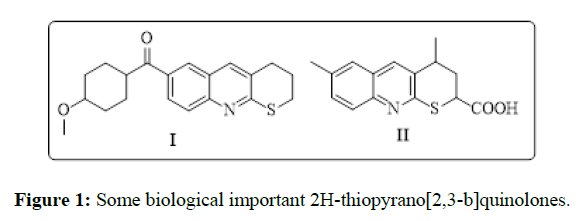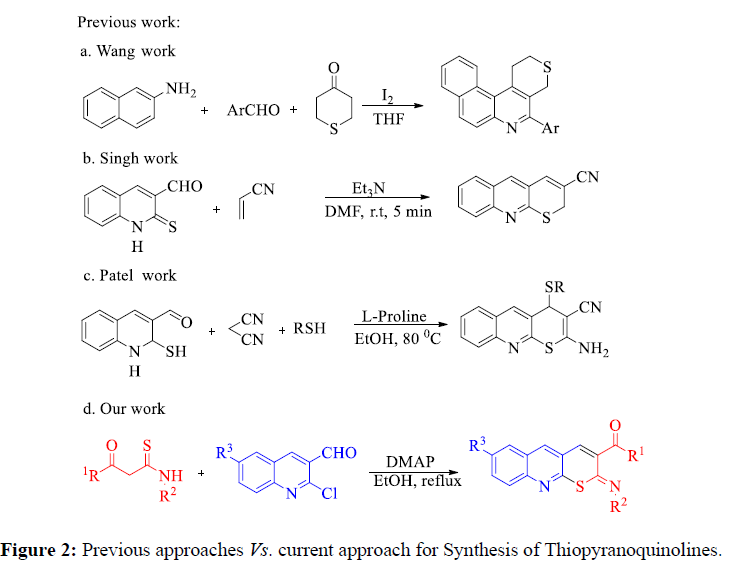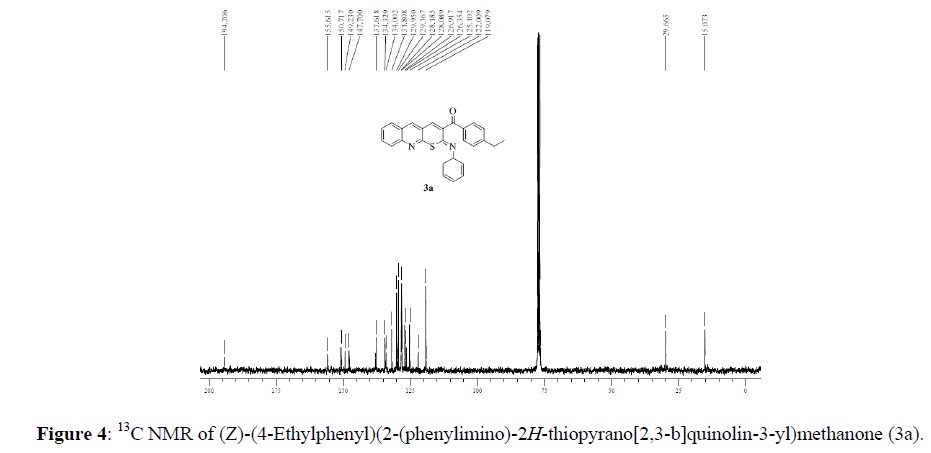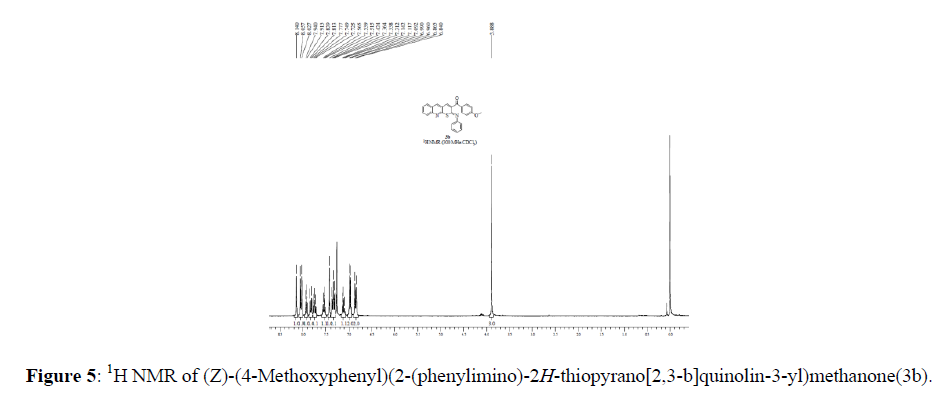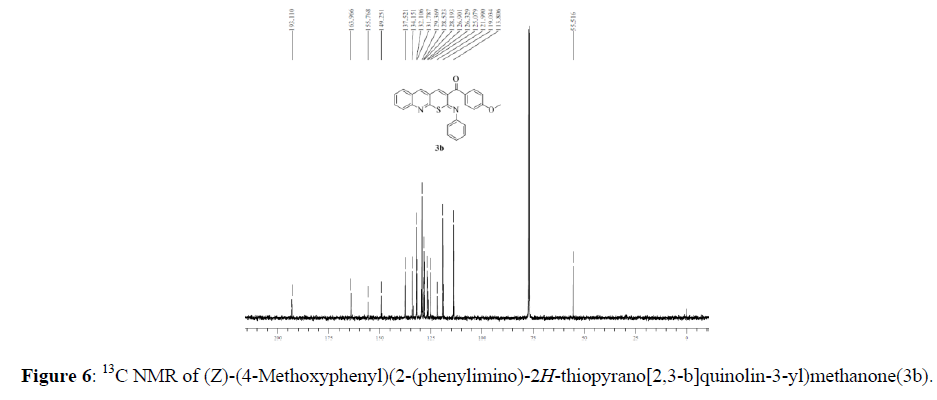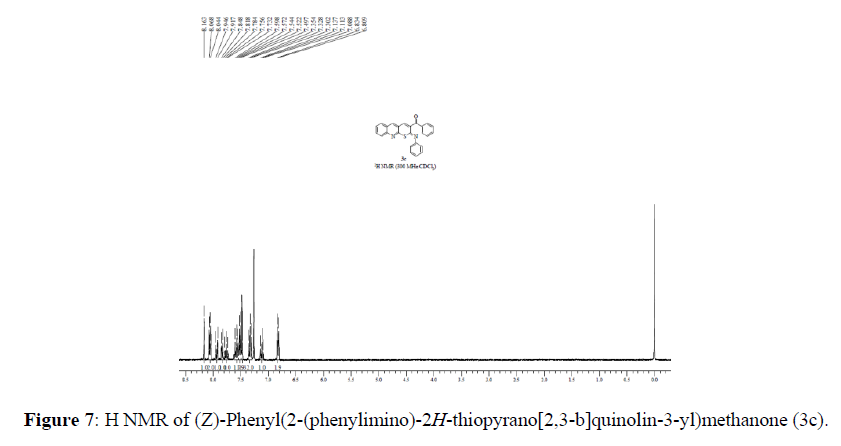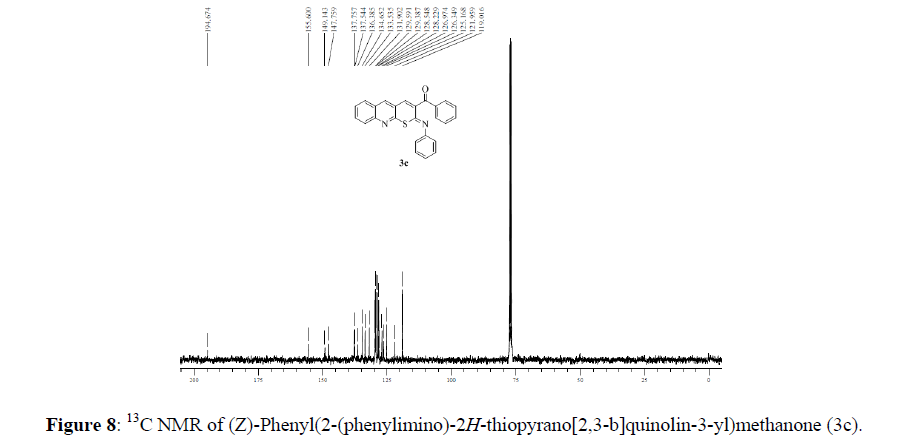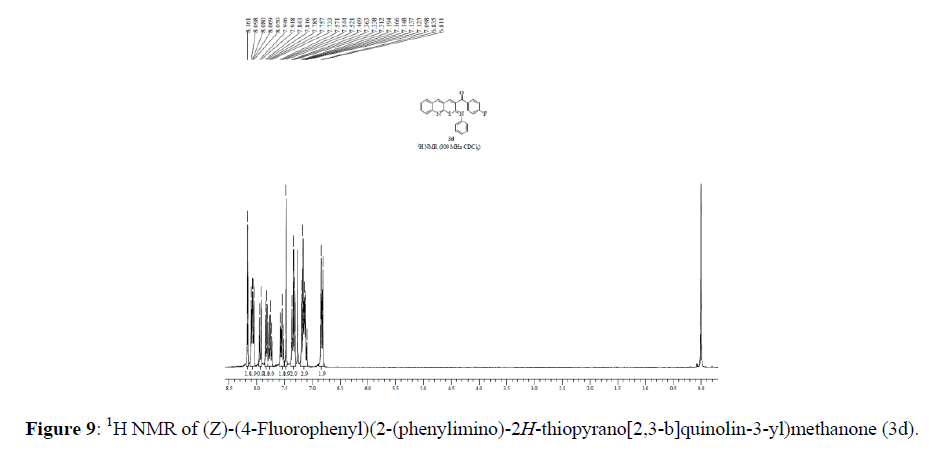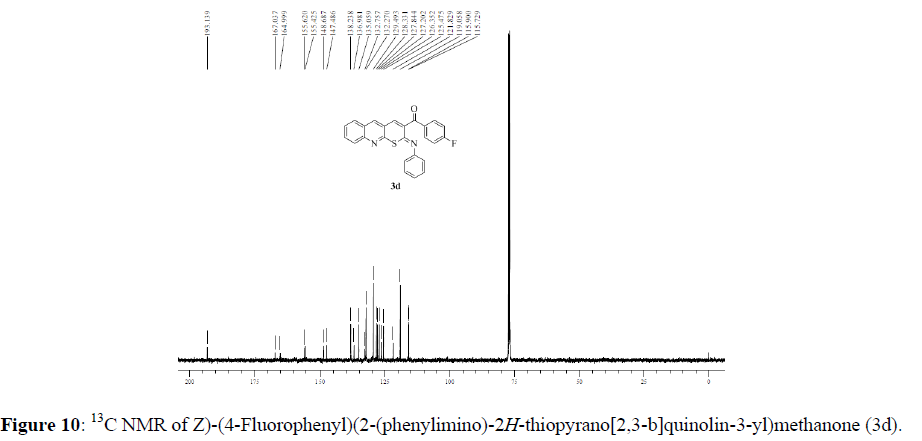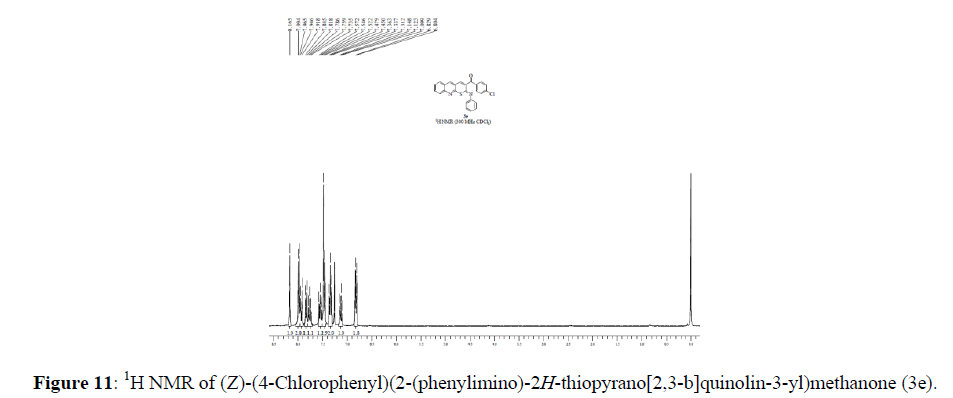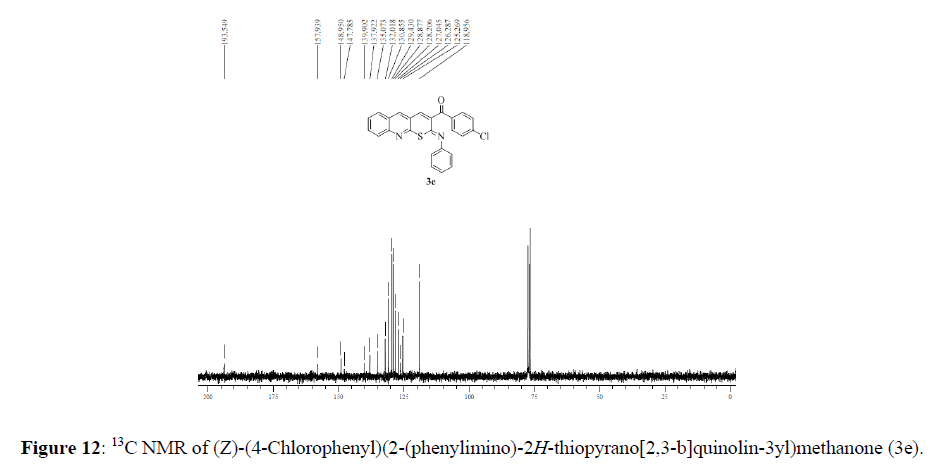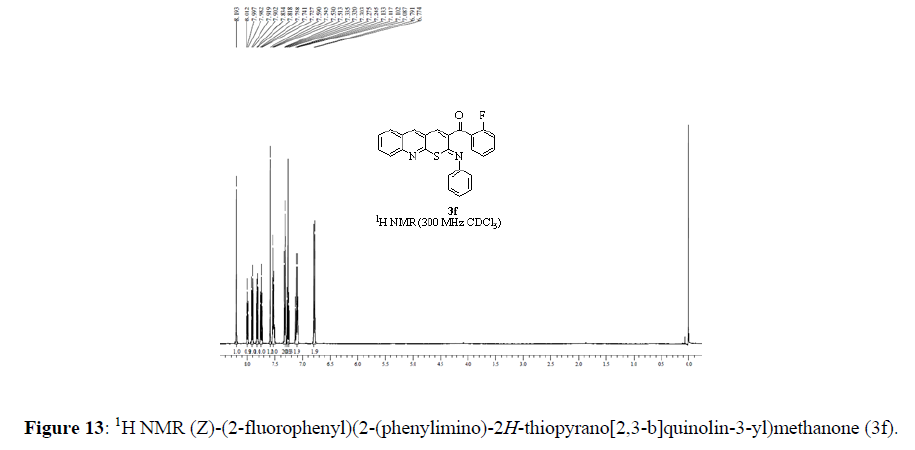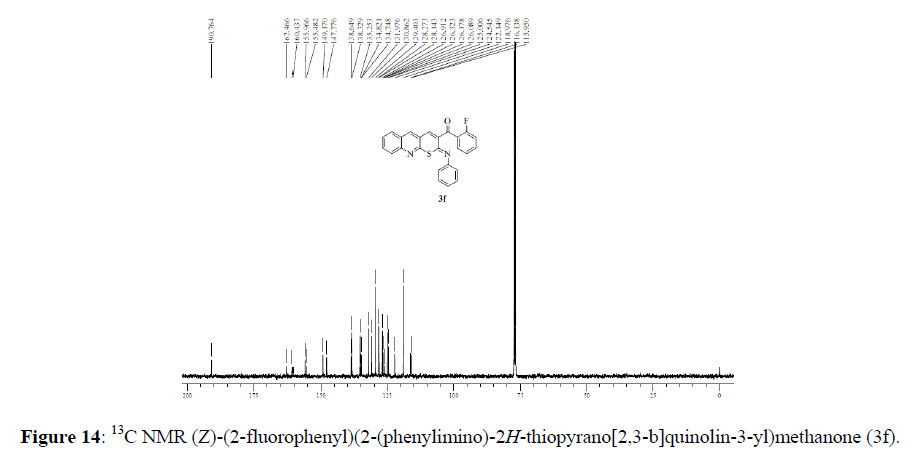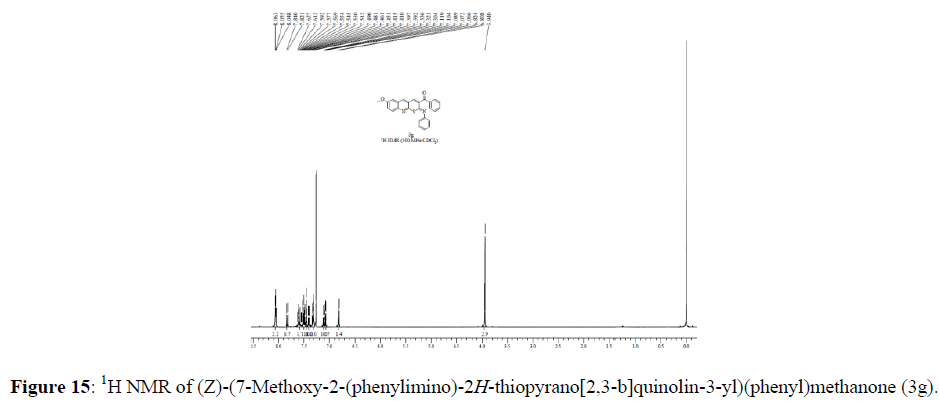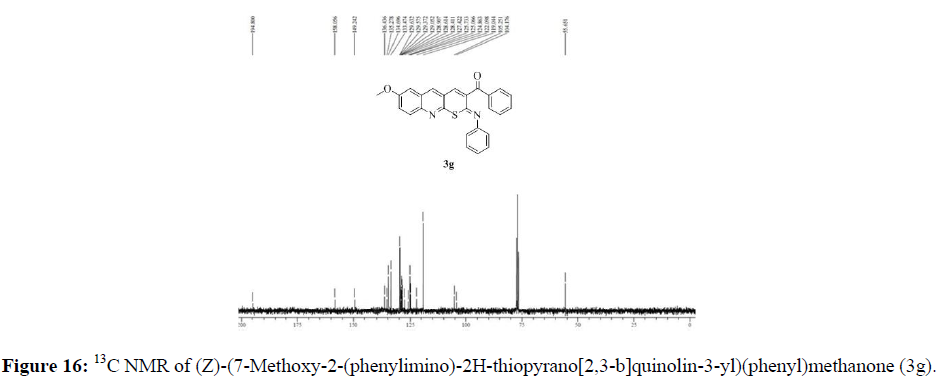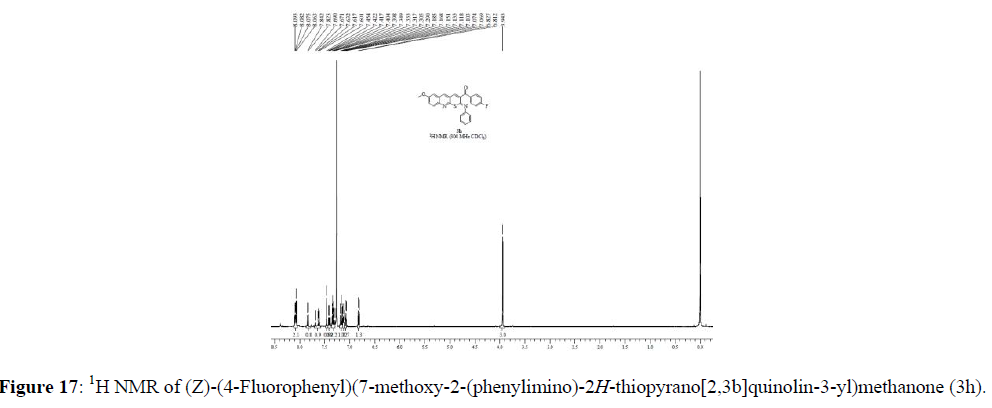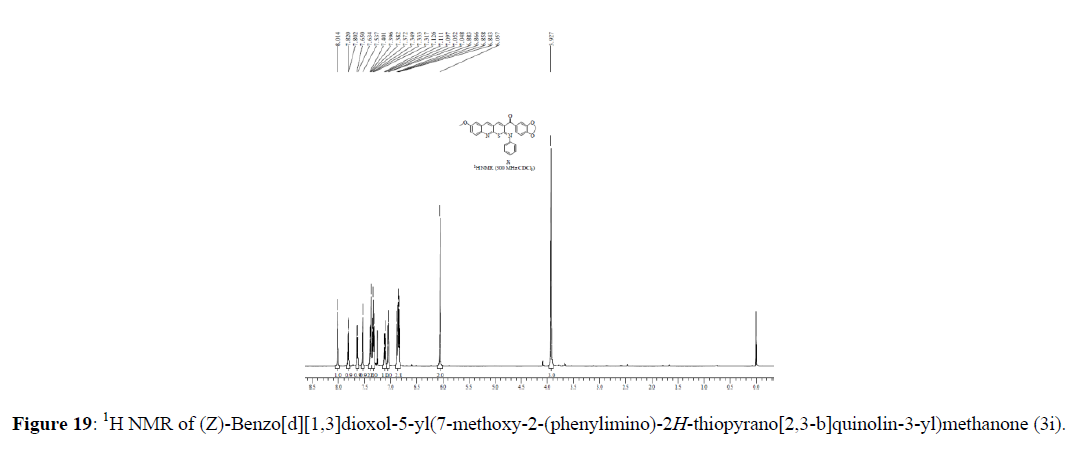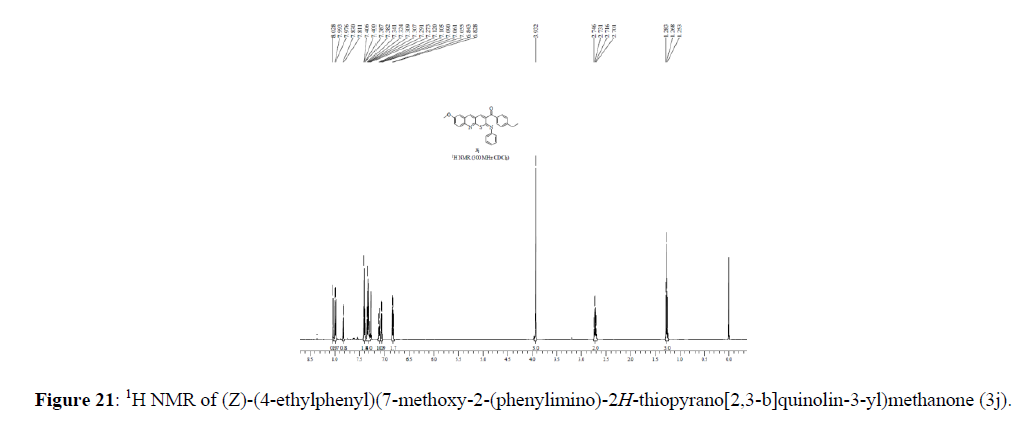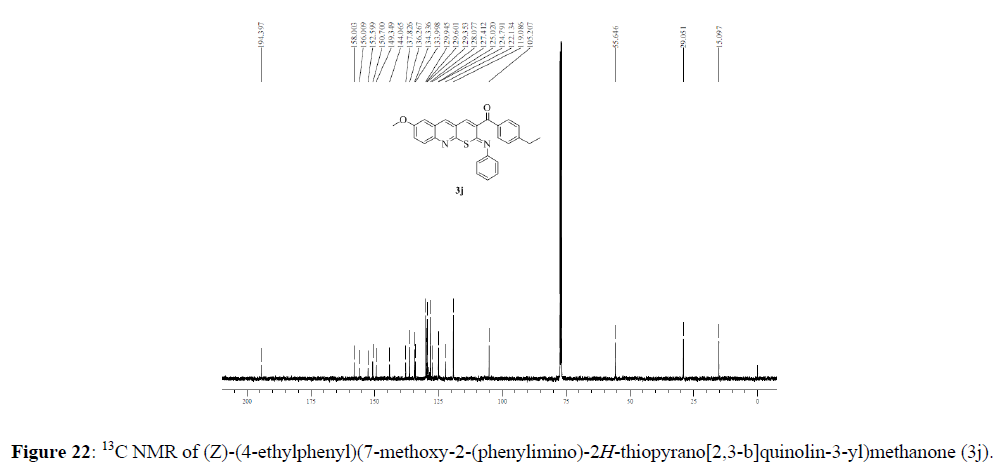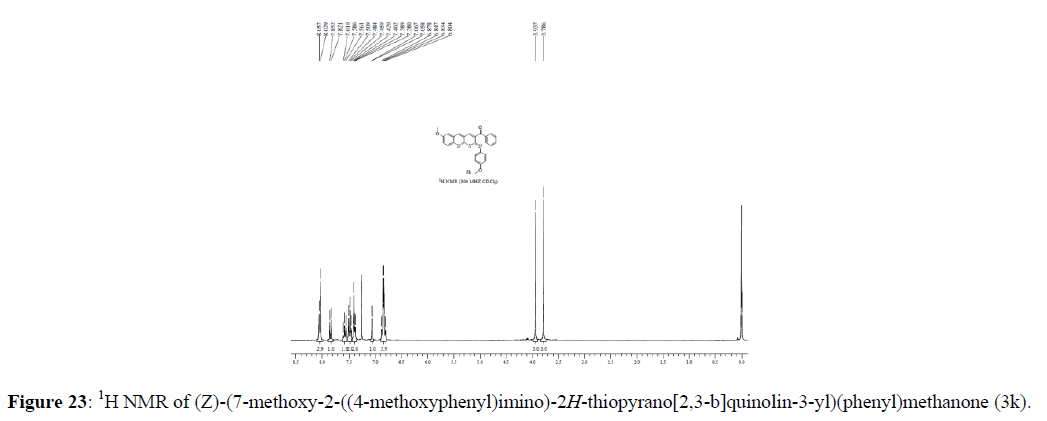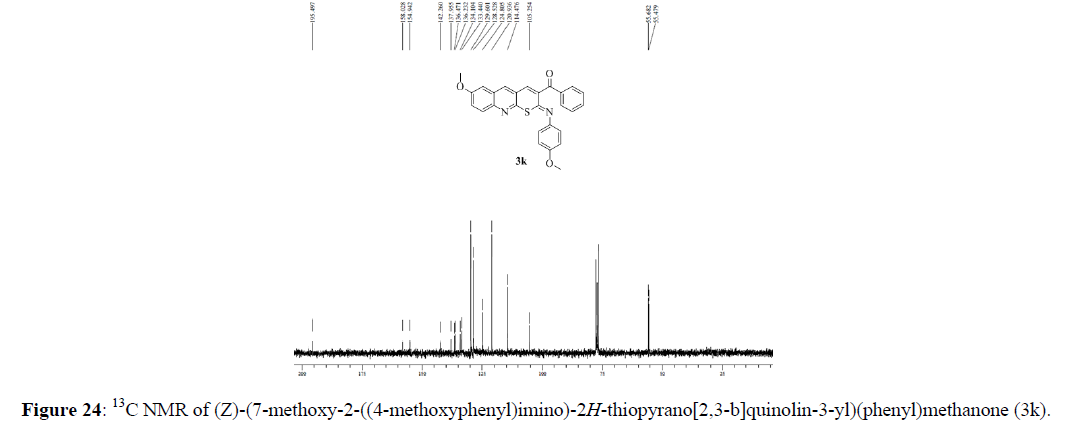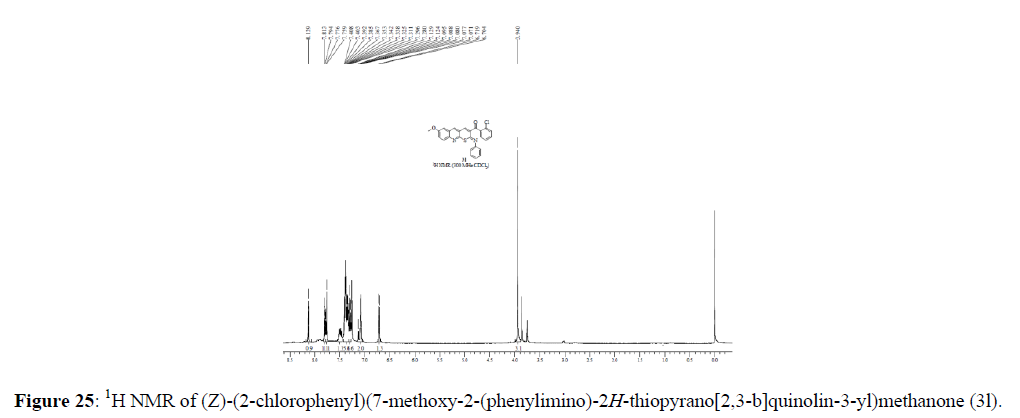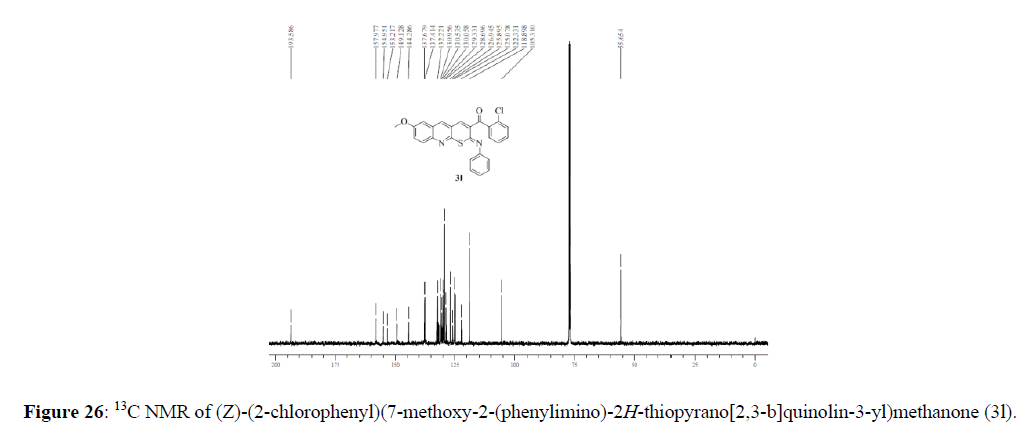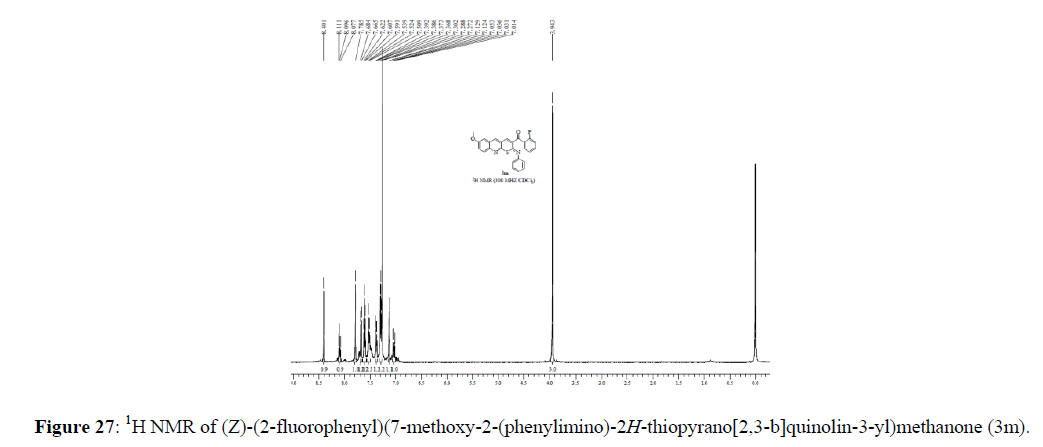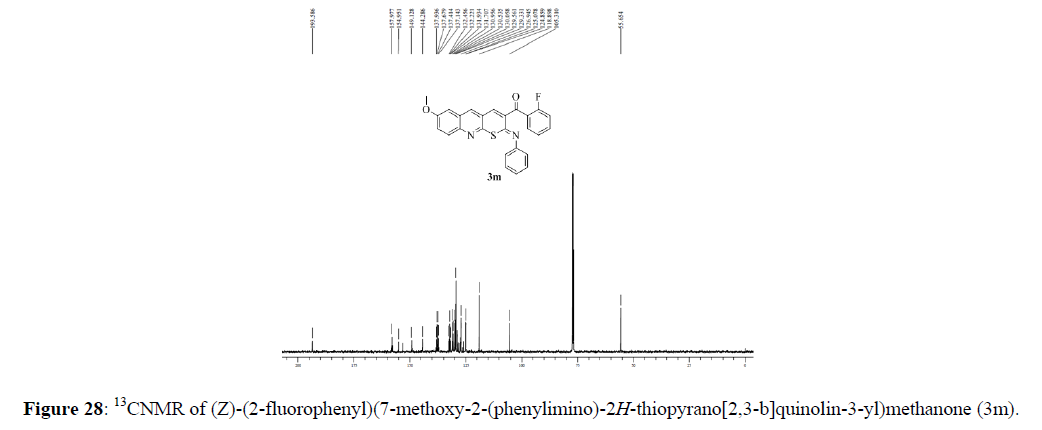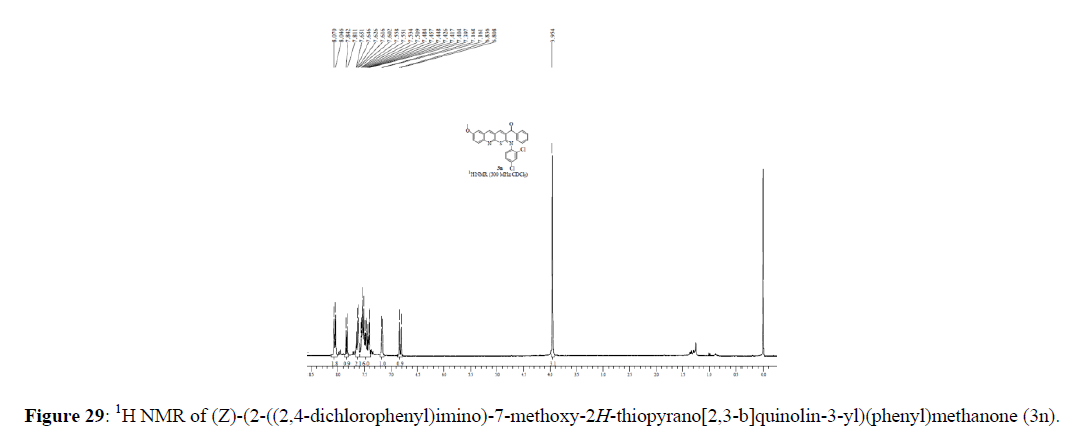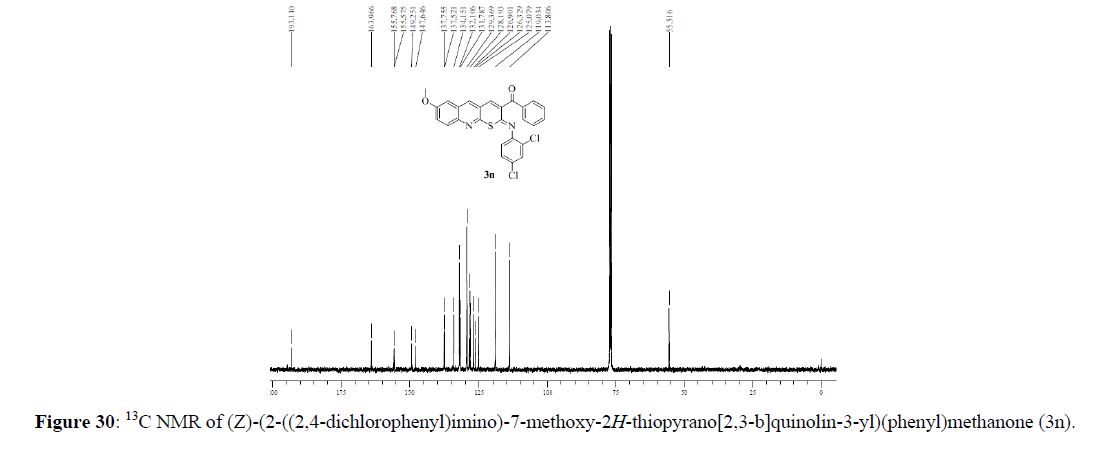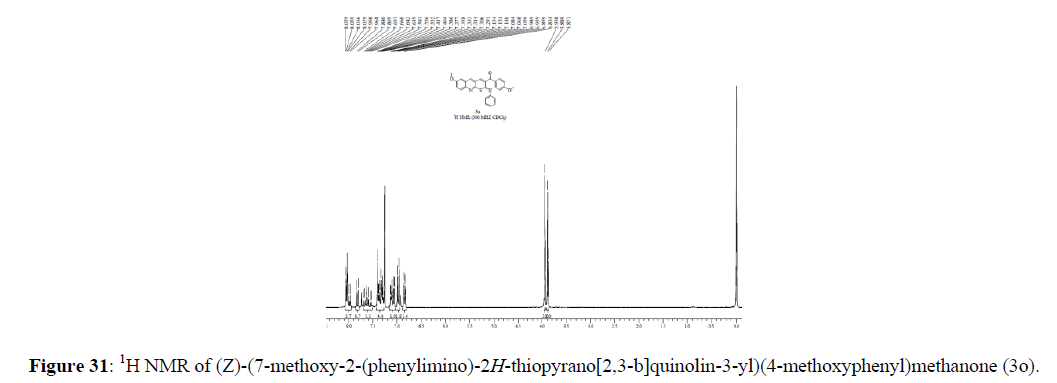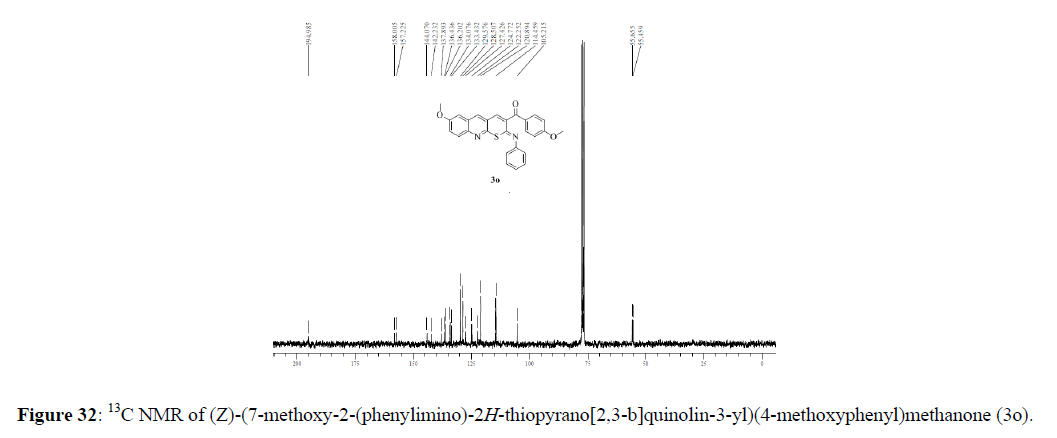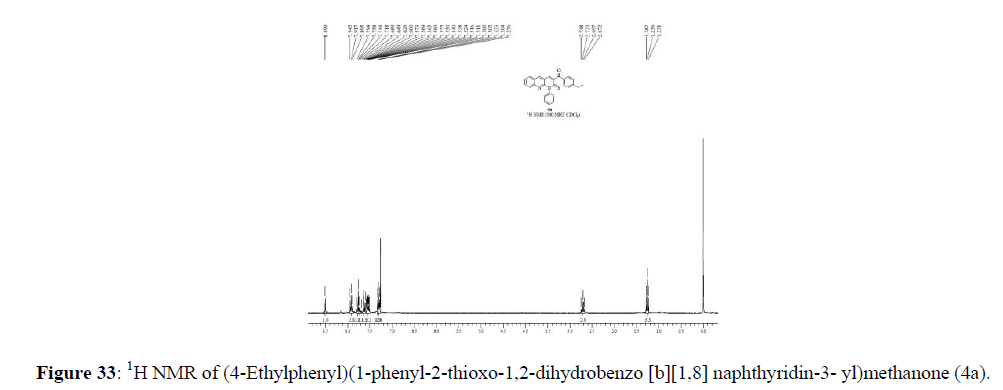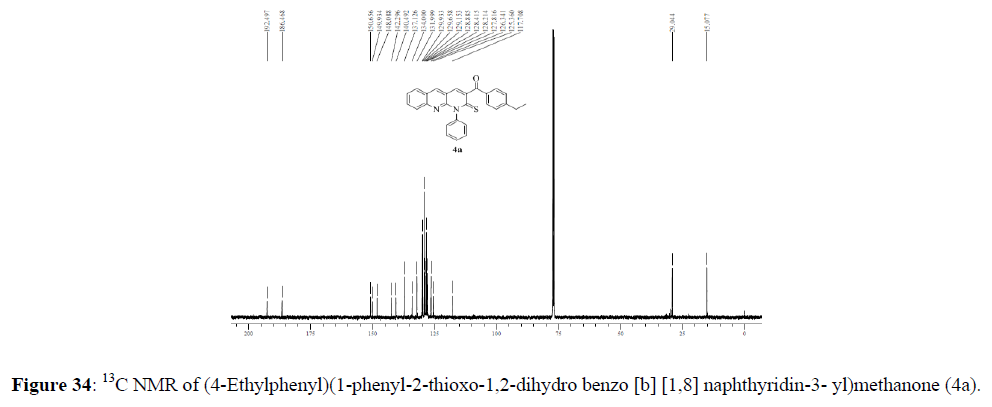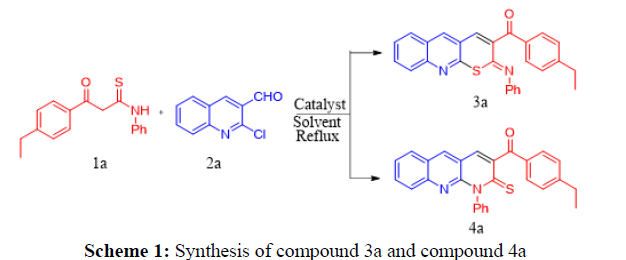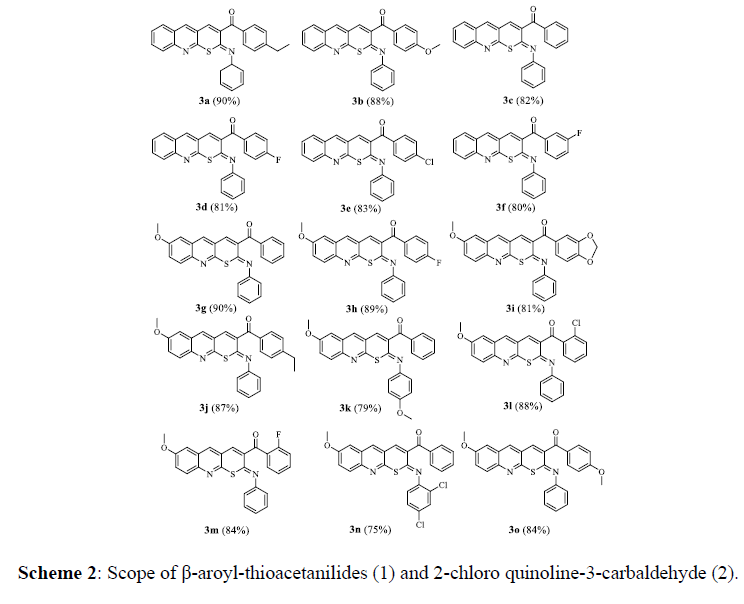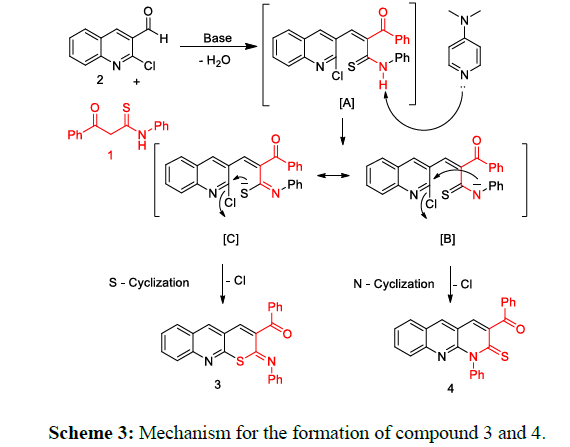Research Article - Der Pharma Chemica ( 2021) Volume 13, Issue 8
DMAP Catalysed Selective Synthesis of Thiopyrano[2,3-B]Quinoline Derivatives through Cascade Protocol
Sreenivas Avula* and Srikanth Reddy NarraSreenivas Avula, Fluoroorganics Division, CSIR-Indian Institute of Chemical Technology, Tarnaka, Hyderabad, Telangana-500607, India, Tel: +91-9346676343, Email: srinu.avula343@gmail.com
Received: 01-Aug-2021 Accepted Date: Aug 17, 2021 ; Published: 31-Aug-2021
Abstract
A convenient and rapid synthesis of hitherto unknown Thiopyrano[2,3-b]quinoline derivatives (3) from β-aroyl-thioacetanilides (1) and 2-chloro quinoline-3-carbaldehyde (2) in the presence of simple organic bases. Initially, β-aroyl-thioacetanilides undergo condensation with 2-chloro quinoline-3-carbaldehyde (2) and followed by intramolecular cyclization (SNAr) to obtained the Thiopyrano[2,3-b]quinoline derivatives (3a-3o). For this transformation, we have found that DMAP is the best catalyst for chemo-selective synthesis of Thiopyrano[2,3-b]quinolones derivatives in high yields. All the final compounds were well characterized by 1H NMR, 13C NMR and HRMS, further confirmed by single X-ray crystallography for 3a and 4a compounds.Keywords
Thiopyrano [2,3-b]quinoline, β-aroyl-thioacetanilides, 2-chloro quinoline-3-carbaldehyde.
Introduction
Construction of new heterocyclic ring systems by using new synthetic techniques is very important in synthetic and medicinal chemistry. From the past several decades quinoline derivatives received the great attention in medicinal chemistry as an active pharmacophores [1] and the fused quinoline derivatives also have the good biological profile such as antibacterial [2,3] antimalarial [4-8] antifungal [9] anti-inflammatory [10] antihypertensive [11] antiproliferative [12] and anticancer [13] agents. The thiopyran fused quinoline framework which have structural similarities with MT477 (potential anticancer drug with a high activity against protein kinase C (PKC) isoforms [14] also possess a remarkable biological activities such as antagonistic activity [15-17] and antioxidant [18] agents. Some representative examples are outlined in Figure 1. In view of the importance of thiopyrano [2,3-b]quinoline it is necessary to develop an efficient method for the construction of this heterocyclic skeleton containing analogues.
There are few reports available in literature on the synthesis of thiopyrano [2,3-b] quinoline derivatives. In 2009,wang and co-workers [19] reported the synthesis of thiopyran fused quinoline derivatives starting from aromatic aldehydes, naphthalen-2- amine and tetrahydrothiopyran-4-one in the presences of I2 (Figure 2a). After that, Singh and co-workers [20] pioneered the synthesis of fused thiopyranquinolone from 2-thione analogs of 3-formylquinolines and acrylonitrile (via Domino Michael addition followed by cyclization reaction) in the presences of triethylamine (Figure 2b). In 2014, Patel and co-workers [21] synthesized 4H-substituted thiopyrano [2,3-b]quinolines derivatives from 2-mercaptoquinoline-3-carbaldehyde, malononitrile and thiol-based nucleophiles in the presences of L-Proline (Figure 2c). However to the best of our knowledge DMAP annulation reaction of β -ketothioamides and 2-chloroquinoline-3-carbaldehydes has not reported before, In continuation of our efforts on synthesis of novel heterocyclic compounds, by utilizing β-aroyl-thioacetanilides [22-25] we report here the synthesis of novel thiopyrano [2, 3-b] quinoline (3) derivatives from 2-chloro quinoline-3-carbaldehyde in very good yields using DMAP as a catalyst.
Materials and Methods
General
Melting points were recorded on a Veego programmable melting point apparatus and are uncorrected. IR spectra were recorded on a PerkineElmer FT-IR 240-Cspectrophotometer using KBr optics. 1H NMR spectra were recorded on Bruker AV 300 MHz in CDCl3 using TMS as internal standard. Electron Spray Ionization (ESI) and high-resolution mass spectra were recorded on QSTARXL hybrid MS/MS system (Applied Biosystems, USA). All the reactions were monitored by thin layer chromatography (TLC) on pre-coated silica gel 60F254 (mesh); spots were visualized under UV light. The crystallographic data can be obtained free of charge at www.ccdc.cam.ac.uk/conts/retrieving.html or from the Cambridge Crystallographic Data Centre (CCDC), 12 Union Road, Cambridge CB2 1EZ, UK; fax: +44(0) 1223 336 033; email: deposit@ccdc.cam.ac.uk.
General method for Synthesis of the thiopyrano[2,3-b]quinoline derivatives (3a-3o)
An equimolar mixture of 3-(4-ethylphenyl)-3-oxo-N-phenylpropane thioamide 1a (283 mg, 1.0 mmol)) and 2-chloro-6-methoxy quinoline-3- carbaldehyde 2b (221 mg, 1.0 mmol)) was stirred under refluxed in ethanol (15mL) containing DMAP (N,N-dimethy,4- amino pyridine) (12.2mg, 0.1mmol) for 4 h. After completion of the reaction (monitored by TLC), the reaction mixture was allowed to room temperature, and ethanol was evaporated under reduced pressure then the reaction mixture was diluted with water (15mL) and extracted with ethyl acetate (2*15mL), the combined organic layers were washed with brine (2*15mL) dried over Na2SO4 , filtered and concentrated in vacuo. The crude was purified by column chromatography to afford (Z)-(4-Ethyl phenyl)(2-(phenylimino)-2H-thiopyrano[2,3-b] quinolin-3-yl)methanone (3a) (378.9 mg, 90%). Similar procedure is adopted to prepare remaining compounds (3a-3o).
(Z)-(4-Ethylphenyl)(2-(phenylimino)-2H-thiopyrano [2,3-b]quinolin-3-yl)methanone (3a)
Yellow solid; Yield: 90%; Rf (30% EtOAc/hexane) 0.50; mp < 250oC1H NMR (300 MHz, CDCl3) δ 1.26 (t, J = 7.5 Hz, 3H), 2.76-2.69 (q, J = 7.5 Hz, 2H), 6.84 (d, J = 7.5 Hz, 2H), 7.11 (t, J = 7.5 Hz, 1H), 7.33 (t, J = 8.3 Hz, 4H), 7.43 (s, 1H), 7.53 (t, J = 7.5 Hz, 1H), 7.74 (t, J = 7.5 Hz, 1H) 7.82 (d, J = 8.3 Hz, 1H), 7.92 (d, J = 8.3 Hz, 1H), 7.96 (d, J = 8.3 Hz, 2H), 8.14 (s, 1H); 13C NMR (75 MHz, CDCl3) δ 15.0, 29.6, 119.0, 122.0, 125.1, 126.3, 126.9, 128.0, 129.3, 129.9, 131.8, 134.0, 134.3, 137.6, 147.7, 149.2, 150.7, 155.6, 194.2; ; IR (KBr) υmax 2967, 1669, 1552, 1563, 1259, 695 cm-1; ESI-MS421 [M+H]+; HRMS (ESI) calcd for C27H20N2OS [M+H]+ 421.13691, found 421.13537. (Figures 3,4)
(Z)-(4-Methoxyphenyl)(2-(phenylimino)-2H-thiopyrano [2,3-b]quinolin-3-yl)methanone (3b)
Yellow solid; Yield: 88%; Rf (30% EtOAc/hexane) 0.48; m.p. 191-192oC; 1H NMR (300 MHz, CDCl3) δ 3.88 (s, 3H), 6.85 (d, J = 7.5 Hz, 2H), 6.97 (d, J = 8.8, Hz, 2H), 7.11 (t, J = 7.5 Hz, 1H), 7.33 (t, J = 7.7 Hz, 2H), 7.4(s, 1H), 7.53 (t, J = 7.7 Hz, 1H), 7.74 (t, J = 8.3 Hz, 1H), 7.82 (d, J = 7.9 Hz, 1H), 7.92 (d J = 8.3 Hz, 1H), 8.04 (d, J = 8.8 Hz, 2H),8.14(s, 1H);13C NMR (75 MHz, CDCl3) δ55.5. 113.8, 119.0, 121.9, 125.2,126.7, 126.9,128.1, 128.5, 129.2, 129.3, 129.5, 131.7, 132.1, 133.5, 134.1, 134.6, 137.5,137.7, 147.6, 149.2, 155.5, 155.7, 163.9, 193.1; IR (KBr) υmax 1662, 1587, 1568, 1552, 1253, 758, 701 cm-1; ESI-MS 423 [M+H]+; HRMS (ESI) calcd for C26H18O2N2S [M+H]+423.11618, found 423.11645. (Figure 5,6)
(Z)-Phenyl(2-(phenylimino)-2H-thiopyrano[2,3-b] quinolin-3-yl)methanone (3c)
Yellow solid; Yield: 82%; Rf (30% EtOAc/hexane) 0.49;m.p. 190-191oC; 1H NMR (300 MHz, CDCl3) δ 6.82 (d, J = 8.3 Hz, 2H), 7.11 (t, J =7.5 Hz, 1H), 7.32 (t, J = 7.9 Hz, 2H), 7.47 (s, 1H), 7.51 (d, J = 7.5 Hz, 2H), 7.57 (t, J = 7.5 Hz, 2H), 7.75 (t, J = 8.6 Hz, 1H), 7.83 (d, J = 7.9 Hz, 1H), 7.93 (d, J = 8.6 Hz, 1H), 8.05 (d, J = 7.1Hz, 2H), 8.16 (s, 1H); 13C NMR (75 MHz, CDCl3) δ 119.0, 121.9, 125.1, 126.3, 126.9, 128.2, 128.5, 129.3, 129.5, 131.9, 133.5, 134.6, 136.5, 137.5, 137.7, 147.7, 149.1, 155.6, 194.6; IR (KBr) υmax 2925, 1668, 1557, 1263, 719, 698 cm-1; ESI-MS 393 [M+H]+; HRMS (ESI) calcd for C25H16ON2S [M+H]+393.10561, found 393.10574. (Figures 7,8)
(Z)-(4-Fluorophenyl)(2-(phenylimino)-2H-thiopyrano [2,3-b]quinolin-3-yl)methanone (3d)
Yellow solid; Yield: 81%; Rf (30% EtOAc/hexane) 0.48; m.p. 166-167°C; 1H NMR (300 MHz, CDCl3) δ 6.82 (d, J = 7.3 Hz, 2H), 7.19-7.09 (m, 3H), 7.33 (t, J = 7.9Hz, 2H), 7.46 (s, 1H), 7.54 (t, J = 7.9 Hz, 1H), 7.76 (t, J = 8.3 Hz, 1H), 7.82 (d, J = 8.3 Hz, 1H), 7.93 (d, J = 8.3 Hz, 1H), 8.09-8.05 (q, 2H), 8.16 (s, 1H); 13C NMR (75MHz, CDCl3) δ 115.8 (d, J = 21.79 Hz), 119.0, 121.8, 125.4, 126.3, 127.2, 127.8, 128.3, 129.4, 132.2 (d, J = 6.35 Hz), 132.7 (d, J = 2.72 Hz), 135.0, 136.9, 138.2, 147.4, 148.6, 155.4, 155.6, 165.9 (d, J = 256.12 Hz), 193.1; IR (KBr) υmax 1667, 1595, 1548, 1257, 754 cm-1; ESI-MS 411 [M+H]+; HRMS (ESI) calcd for C25H15ON2FS [M+H]+411.09619, found 411.09588.(Figure 9 and 10)
(Z)-(4-Chlorophenyl)(2-(phenylimino)-2H-thiopyrano [2,3-b]quinolin-3-yl)methanone (3e)
Yellow solid; Yield: 83%; Rf (30% EtOAc/hexane) 0.49; m.p. 202-203oC; 1H NMR (300 MHz, CDCl3) δ 6.81 (d, J = 7.5 Hz, 2H), 7.12 (t, J = 7.7 Hz, 1H), 7.33 (t, J = 7.7 Hz, 2H), 7.46 (d, J = 8.8 Hz, 3H), 7.54 (t, J = 7.7 Hz, 1H) ), 7.75 (t, J = 8.1, Hz, 1H), 7.83 (d, J = 8.1 Hz, 1H), 7.93 (d, J = 8.4 Hz, 1H), 7.97 (d, J = 8.4 Hz, 2H), 8.16 (s, 1H); 13C NMR (75 MHz, CDCl3) δ 118.9, 121.8, 125.2, 126.2, 127.0, 128.2, 128.8, 129.4, 130.8, 132.0, 134.7, 135.0, 137.0, 137.7, 139.9, 147.7, 148.9, 155.4, 193.5; IR (KBr) υmax 3052, 1665, 1588, 1544, 1256, 1083, 756 cm-1; ESI-MS 427 [M+H]+; HRMS (ESI) calcd for C25H15ON2ClS [M+H]+427.06664, found 427.06607. (Figure 11and 12)
(Z)-(2-fluorophenyl)(2-(phenylimino)-2H-thiopyrano [2,3-b]quinolin-3-yl)methanone (3f)
Yellow solid; Yield: 88%; Rf (30% EtOAc/hexane) 0.48;m.p. 152-153oC; 1H NMR (300 MHz, CDCl3) δ 6.78 (d, J = 8.3 Hz, 2H), 7.13 – 7.08 (m, 2H), 7.27 (s, 1H), 7.32 (t, J= 8.3 Hz, 2H), 7.53 (t, J= 7.0 Hz, 2H), 7.59 (s, 1H), 7.74 (t, J= 8.3 Hz,1H), 7.82 (d, J= 7.6 Hz, 1H), 7.91 (d, J= 9.0 Hz, 1H), 7.99 (t, J= 7.6 Hz, 1H), 8.19 (s 1H); 13C NMR (75 MHz, CDCl3) δ 116.04 (d, J= 23.61 Hz), 118.9, 122.1, 124.53 (d, J= 2.72 Hz), 125.0, 126.13 (d, J= 10.89 Hz), 126.3, 126.9, 128.20 (d, J= 16.34 Hz), 129.4, 130.8, 131.9, 134.78 (d, J= 9.08 Hz), 135.2, 138.3, 138.6, 147.7, 149.1, 155.4, 155.9, 161.45 (d, J= 255.2 Hz), 190.7; IR (KBr) υmax 2925, 1655, 1610, 1586, 1556, 1286, 753 cm-1; ESI-MS 411 [M+H]+; HRMS (ESI) calcd for C25H15ON2FS [M+H]+411.09619, found 411.09595. (Figure 13 and 14)
(Z)-(7-Methoxy-2-(phenylimino)-2H-thiopyrano[2,3-b] quinolin-3-yl)(phenyl)methanone (3g)
Yellow solid; Yield: 90%; Rf (30% EtOAc/hexane) 0.50;m.p. 167-168 oC; 1H NMR (300 MHz, CDCl3) δ 3.94 (s, 3H), 6.81 (d, J = 8.2 Hz, 2H), 7.07 (d, J = 3.2 Hz, 1H), 7.10 (t, J = 7.4 Hz, 1H), 7.32 (t, J = 8.2 Hz, 2H),7.41-7.39 (q, 1H), 7.45 (d, J = 4.5 Hz, 1H), 7.49 (t, J = 7.4 Hz, 2H), 7.62-7.53 (m, 2H), 7.83 (d, J = 9.3 Hz, 1H), 8.05 (t, J = 3.2 Hz, 2H); 13C NMR (75 MHz, CDCl3) δ 55.6, 104.1, 105.2, 119.0, 122.0, 124.8, 125.0, 125.7, 127.4, 128.4, 128.6, 128.9, 129.0, 129.3, 129.5, 129.6, 133.4, 134.6, 135.2, 136.4, 149.2, 158.0, 194.8; IR (KBr) υmax 3423, 3057, 2926, 1666, 1619, 1552, 1221 cm-1; ESI-MS 423 [M+H]+; HRMS (ESI) calcd for C26H18O2N2S [M+H]+423.11618, found 423.11556. (Figure 15and16)
(Z)-(4-Fluorophenyl)(7-methoxy-2-(phenylimino)-2H-thiopyrano[2,3-b]quinolin-3-yl)methanone (3h)
Yellow solid; Yield: 89%; Rf (30% EtOAc/hexane) 0.48; m.p. 179-180 oC; 1H NMR (300 MHz, CDCl3) δ 3.94 (s, 3H), 6.81 (d, J = 7.3 Hz, 1H), 7.07 (d, J = 2.7 Hz, 1H), 7.11 (t, J = 7.3 Hz, 2H), 7.16 (t, J = 8.5 Hz, 2H), 7.34 - 7.29 (m, 2H), 7.42 - 7.39 (m, 1H), 7.45 (s, 1H), 7.69 - 7.60 (m, 1H), 7.83 (d, J = 9.1 Hz, 1H), 8.09 -8.06 (m, 2H); 13C NMR (75 MHz, CDCl3) δ 55.6, 105.2, 115.72 (d, J = 21.79 Hz), 118.9, 121.9, 124.9,125.1, 125.8, 126.3, 127.3, 128.4, 128.8, 129.4, 129.62 (d, J = 8.17 Hz), 132.20 (d, J = 9.99 Hz), 132.8, 134.8, 135.3, 136.5, 137.2, 140.3, 141.1, 149.1, 152.4, 155.9, 158.0, 165.92 (d, J = 255.21 Hz), 193.27; IR (KBr) υmax 3055, 2928, 1665, 1621, 1596, 1552, 1224, 694 cm-1; ESI-MS 441[M+H]+; HRMS (ESI) calcd for C26H17O2FN2S [M+H]+ 441.10675,found441.10592. (Figure 17 and 18)
(Z)-Benzo[d][1,3]dioxol-5-yl(7-methoxy-2-(phenylimino) -2H-thiopyrano[2,3-b]quinolin-3-yl)methanone (3i)
Yellow solid; Yield: 81%; Rf (30% EtOAc/hexane) 0.46; m.p. 181-182oC 1H NMR (300 MHz, CDCl3) δ 3.92 ( s, 3H), 6.05 (s, 2H), 6.85 (d, J = 7.4 Hz, 2H), 6.87 (d, J = 8.2 Hz, 1H), 7.05 (d, J = 2.2 Hz, 1H), 7.11 (t, J = 7.4 Hz, 1H),7.33 (t, J = 7.9 Hz, 2H), 7.40-7.32 (m, 2H), 7.53 (s, 1H), 7.64 (d, J = 8.2 Hz, 1H), 7.81( d, J=9.1 Hz,1H), 8.01(s, 1H); 13C NMR (75 MHz, CDCl3) δ 55.6, 101.9, 105.1, 107.9, 108.8, 119.0, 122.0, 124.7, 125.0, 126.8, 127.3, 129.3, 129.5, 131.1, 134.2, 136.2, 137.5, 144.0, 148.2, 149.3, 152.2, 152.4, 156.0, 157.9, 192.8; ; IR (KBr) υmax 2912, 1658, 1622, 1558, 1490, 1440, 1259, 1215, 1034 cm-1; ESI-MS 467 [M+H]+; HRMS (ESI) calcd for C27H18N2O4S [M+H]+ 467.51100, found 467.51110.(Figure 19,20)
(Z)-(4-ethylphenyl)(7-methoxy-2-(phenylimino)-2H-thiopyrano[2,3-b]quinolin-3-yl)methanone (3j)
Yellow solid; Yield: 87%; Rf (30% EtOAc/hexane) 0.52; m.p. 182-183 oC; 1H NMR (300 MHz, CDCl3) δ 1.26 (t, J = 7.6 Hz, 3H ), 2.74 –2.70 (q, 2H), 3.93 (s, 3H), 6.83 (d, J = 7.3 Hz, 2H), 7.05 (d, J = 2.7 Hz, 1H), 7.10 (t, J = 7.4 Hz, 1H), 7.34 - 7.29 (m, 4H), 7.40 – 7.38 (m, 2H), 7.82 (d, J = 9.3 Hz, 1H), 7.98 (d, J = 8.4 Hz, 2H), 8.02 (s, 1H); 13C NMR (75 MHz, CDCl3) δ 15.0, 29.0, 55.6, 105.2, 119.0, 122.1, 124.7, 125.0, 127.4, 128.0, 128.9, 129.3, 129.6, 129.9, 133.9, 134.3, 136.2, 137.8, 144.0, 149.3, 150.7, 152.5, 156.0, 158.0, 194.3; IR (KBr) υmax 2915, 1629, 1615, 1530, 1218, 1020 cm-1; ESI-MS 451 [M+H]+; HRMS (ESI) calcd for C28H22N2O2S [M+H]+ 451.14655, found 451.14655. (Figure 21 and 22)
(Z)-(7-methoxy-2-((4-methoxyphenyl)imino)-2H-thiopyrano[2,3-b]quinolin-3-yl) (phenyl)methanone (3k)
Yellow solid; Yield: 79%; Rf (30% EtOAc/hexane) 0.50; m.p. 191-192 oC; 1H NMR (300 MHz, CDCl3) δ 3.78 (s, 3H), 3.93 (s, 3H), 6.87 – 6.80 (m, 4H), 7.06 (d, J = 2.6 Hz, 1H), 7.40 - 7.38 (m, 2H), 7.48 (t, J = 7.5 Hz, 2H), 7.58 (t, J = 7.5 Hz, 1H), 7.83 (d, J = 9.2 Hz, 1H), 7.04 (d, J = 8.5 Hz, 3H); 13C NMR (75 MHz, CDCl3) δ 55.4, 55.6, 105.2, 114.4, 120.9, 124.8, 128.5, 129.6, 133.4, 134.1, 136.2, 136.4, 137.9, 142.2, 154.9, 158.0, 195.4; IR (KBr) υmax 3414, 2928, 1674, 1626, 1546, 1493, 1218, 1163 cm-1; ESI-MS 453 [M+H]+; HRMS (ESI) calcd for C27H20N2O3S [M+H]+ 453.12674, found 453.12556. (Figure 23,24)
(Z)-(2-chlorophenyl)(7-methoxy-2-(phenylimino)-2H-thiopyrano[2,3-b]quinolin-3-yl) methanone (3l)
Yellow solid; Yield: 88%; Rf (30% EtOAc/hexane) 0.51; m.p. 176-177 oC; 1H NMR (300 MHz, CDCl3) δ 3.94 (s, 3H), 6.71 (d, J = 7.4 Hz, 1H), 7.12 - 7.07 (m, 2H), 7.29 (t, J = 7.7 Hz, 2H), 7.40 – 7.31 (m, 6H), 7.76 (d, J = 8.3 Hz, 1H), 7.80 (d, J = 9.4 Hz, 1H), 8.129 (s, 1H); 13C NMR (75 MHz, CDCl3) δ 55.6, 105.3, 118.8, 125.0, 126.9, 129.3, 129.5, 130.0, 130.5, 130.9, 132.2, 136.0, 137.1, 137.4, 137.6, 137.9, 144.2, 149.1, 153.2, 154.9, 157.9, 160.0, 193.5; IR (KBr) υmax 2930, 1652, 1625, 1520, 1215, 1034, 742 cm-1; ESI-MS 457 [M+H]+; HRMS (ESI) calcd for C26H17N2O2ClS [M+H]+ 457.06993, found 457.06988. (Figure 25 and 26)
(Z)-(2-fluorophenyl)(7-methoxy-2-(phenylimino)-2H-thiopyrano[2,3-b]quinolin-3-yl)methanone (3m)
Yellow solid; Yield: 84%; Rf (30% EtOAc/hexane) 0.48; m.p. 185-186 oC; 1H NMR (300 MHz, CDCl3) δ 3.94 (s, 3H), 7.05 – 7.01 (m, 1H), 7.12 (d, J = 2.6 Hz, 1H), 7.28 (t, J = 7.7 Hz, 3H), 7.39 - 7.36 (m, 1H), 7.52 (t, J = 7.4 Hz, 2H), 7.60 (t, J = 7.7 Hz, 2H), 7.67 (d, J = 9.3 Hz, 1H), 7.78 (s, 1H), 8.09 (t, J = 7.7 Hz, 1H), 8.40 (s, 1H); 13C NMR (75 MHz, CDCl3) δ 55.6, 105.3, 118.8, 124.8, 125.0, 126.9, 129.3, 129.5, 130.0, 130.5, 130.9, 131.7, 131.9, 132.33 (d, J = 27.10 Hz), 137.27 (d, J = 30.1 Hz), 137.6, 137.9, 144.2, 149.1, 156.4 (d, J = 255.26 Hz), 193.5; IR (KBr) υmax 3414, 2925, 1651, 1607, 1222 cm-1; ESI-MS 441 [M+H]+; HRMS (ESI) calcd for C26H17N2O2SF [M+H]+ 441.11933, found 441.10743. (Figure 27 and 28)
(Z)-(2-((2,4-dichlorophenyl)imino)-7-methoxy-2H-thiopyrano[2,3-b]quinolin-3-yl)(phenyl)methanone (3n)
Yellow solid; Yield: 75%; Rf (30% EtOAc/hexane) 0.49; m.p. 179-180 oC; 1H NMR (300 MHz, CDCl3) δ 3.95 (s, 3H), 6.82 (d, J = 8.4 Hz, 1H), 7.16 (d, J = 3.0 Hz, 1H), 7.55 - 7.39 (m, 6H), 7.65 – 7.60 (m, 2H), 7.82 (d, J = 9.2 Hz, 1H), 8.05 (d, J = 7.1 Hz, 2H); 13C NMR (75 MHz, CDCl3) δ 55.5, 113.8, 119.30, 121.9, 125.0, 126.3, 126.9, 128.5, 129.3, 131.7, 132.1, 134.1, 137.5, 137.7, 147.6, 149.2, 155.5, 155.7, 163.9, 193.1; IR (KBr) υmax 2923, 1667, 1626, 1552, 1232, 1220, 831 cm-1; ESI-MS 491 [M+H]+; HRMS (ESI) calcd for C26H16N2O2SCl2 [M+H]+ 491.03823, found 491.03842.(
(Z)-(7-methoxy-2-(phenylimino)-2H-thiopyrano[2,3-b] quinolin-3-yl)(4-methoxyphenyl) methanone (3o)
Yellow solid; Yield: 84%; Rf (30% EtOAc/hexane) 0.47; m.p. 195-196 °C; 1H NMR (300 MHz, CDCl3) δ 3.88 (d, J = 5.4 Hz, 3H), 3.98 (s, 3H), 6.84 (d, J = 7.31 Hz, 1H), 6.97 (d, J = 9.1 Hz, 2H), 7.13 - 7.05 (m, 2H), 7.41 - 7.29 (m, 4H), 7.69 - 7.53 (m, 1H), 7.82 (d, J = 9.1 Hz, 1H), 8.05 – 7.96 (m, 3H); 13C NMR (75 MHz, CDCl3) δ 55.5, 55.6, 105.1, 113.8, 113.9, 119.0, 122.1, 124.7, 125.0, 125.6, 127.4, 128.8, 129.3, 129.5, 132.1, 134.2, 136.2, 144.0, 149.3, 156.0,157.9, 163.9, 193.2; IR (KBr) υmax2931, 1601, 1546, 1255, 1218, 1029 cm-1; ESI-MS 453 [M+H]+; HRMS (ESI) calcd for C27H20N2O3S [M+H]+ 453.12674, found 453.12567. (Figure 31 and 32)
(4-Ethylphenyl)(1-phenyl-2-thioxo-1,2-dihydrobenzo[b][1,8]naphthyridin-3-yl) methanone (4a)
Brick red solid; Yield (10%); Rf (30% EtOAc/hexane) 0.47; m.p. 245-246oC; 1H NMR (300 MHz, CDCl3) δ 1.25 (t, J = 7.5 Hz, 3H), 2.74-2.67 (q, J = 7.5 Hz, 2H), 7.29 (d, J = 8.3 Hz, 3H), 7.32 (s, 1H), 7.57-7.50 (m, 2H), 7.62 (t, J= 8.3 Hz, 2H), 7.71 (t, J= 10.0 Hz, 1H), 7.77 (d, J= 10.0, 2H), 7.91 (t, J= 8.3 Hz, 3H), 8.49 (s 1H); 13C NMR (75 MHz, CDCl3) δ 15.0, 29.0, 117.7, 125.3, 126.3, 127.8, 128.2, 128.4, 128.8, 129.1, 129.6, 129.9, 131.9, 134.0, 137.1, 140.4, 142.2, 148.0, 149.9, 150.6, 186.4,192.4; IR (KBr) υmax 2926, 1660, 1610, 1287, 730 cm-1; ESI-MS 421[M+H]+; HRMS (ESI) calcd for C27H20ON2S [M+H]+ 421.13691, found 421.13553. (Figure 33 and 34)
Result and Discussion
In a typical reaction, 3-(4-ethylphenyl)-3-oxo-N-phenyl propanethioamide (1a) and 2-chloroquinoline-3-carbaldehyde (2a) were reacted in ethanol using DMAP (10 mol%) as catalyst under different set of conditions. Initially, the reaction was conducted at room temperature for 24 hours and found to be no reaction (Table 1, entry 2). However, the same reaction was conducted under reflux condition for 4 hours (Table 1, entry 3) resulted two isomers such as (Z)-(4-Ethyl phenyl)(2-(phenylimino)-2H-thiopyrano[2,3-b] quinolin-3-yl)methanone 3a (90%, S-cyclization product) and trace amount of (4-Ethylphenyl)(1-phenyl-2-thioxo-1,2-dihydrobenzo[b][1,8 naphthyridin-3-yl)methanone 4a (N-cyclization product). Encouraging by this result, we extensively screened the effect of solvents on the formation of products. The reaction is conducted in different solvents such as toluene, THF, DMF, H2O and Dioxane with DMAP (10 mol%) as a catalyst under reflux conditions and observed the less yields when compared to initial hit solvent ethanol (Table 1, entry 4-9). (Scheme 1).
| S no | Catalyst (mol%) | Solvent | Time(h) | Temp(C) | Yield(3a) | Yield(4a) |
|---|---|---|---|---|---|---|
| 1 | EtOH | 24 | rt | NR | NR | |
| 2 | DMAP(10) | EtOH | 24 | rt | NR | NR |
| 3 | DMAP(10) | EtOH | 4 | reflux | 90 | trace |
| 4 | DMAP(10) | Toluene | 4 | reflux | 85 | trace |
| 5 | DMAP(10) | THF | 4 | reflux | 82 | trace |
| 6 | DMAP(10) | DMF | 4 | reflux | 80 | trace |
| 7 | DMAP(10) | Dioxane | 4 | reflux | 78 | trace |
| 8 | DMAP(10) | CH3CN | 4 | reflux | 81 | trace |
| 9 | DMAP(10) | water | 4 | reflux | NR | NR |
| 10 | DMAP(20) | EtOH | 4 | reflux | 86 | trace |
| 11 | DMAP(5) | EtOH | 4 | reflux | 70 | trace |
| 12 | Piparazine(10) | EtOH | 4 | reflux | 72 | 10 |
| 13 | DABCO(10) | EtOH | 4 | reflux | 65 | 8 |
| 14 | Et3N(10) | EtOH | 4 | reflux | 78 | 8 |
| 15 | ALCL3(10) | EtOH | 4 | reflux | NR | NR |
| 16 | InCL3(10) | EtOH | 4 | reflux | NR | NR |
| 17 | K2CO3(10) | EtOH | 4 | reflux | NR | NR |
| 18 | KOH(10) | EtOH | 4 | reflux | NR | NR |
| 19 | BF3ET2O(10) | EtOH | 4 | reflux | NR | NR |
To study the feasibility, we examined the reaction in ethanol with a different kind of catalysts such as piperazine, DABCO, pyrrolidine, triethylamine, Aluminium(III) chloride, Indium(III) chloride, potassium carbonate, potassium hydroxide, and Boron trifluoride diethyl etherate 10 mol% each under reflux conditions (Table 1, entry 12-19). In the case of piperazine, we found title compound 3a in 72% yield along with the compound dihydrobenzo[b][1,8] naphthyridin (4a) in 10% yield and both these structures are confirmed by a single X-ray crystallography technique. DMAP is the preferred catalyst in ethanol solvent facilitated a higher product yield (Table 1, entry 3). The detailed screening of solvents and catalysts are tabulated in Table 1.
By using the above-optimized conditions, we have synthesized several thiopyrano quinoline compounds and found that it is tolerated in different electron-withdrawing and releasing groups. Compound 1 having electron-donating groups (ethyl or methoxy) proceeded the reaction smoothly to afford the corresponding products 3a (92%), 3b (92%), 3j (87%), and 3o (84%) in excellent yields. The halogen group (fluorine and chlorine on aryl group R1) substituted β-aroyl-thioacetanilides have easily tolerated the reaction and furnished the corresponding products 3d, 3e, 3f, 3h, 3m and 3l respectively in excellent yields (81%, 83%, 80%, 89%, 92% and 95%). Further, we examined the para-methoxy and ortho, para-dichloro substituted β-aroyl-thioacetanilide (on aryl group R2) and observed the product 3k (79%) and 3n (75%) in good yields.
A plausible mechanism for the product formation is indicated in Scheme 3, the first step consists of DMAP catalyzed Knovenagel condensation between the quinoline aldehyde [2] and active methylene group of 3-oxo-N,3-diarylpropanethioamide [1] leading to the formation of intermediate [A] (Z)-2-benzoyl-3-(2-chloroquinolin-3-yl)-N-phenylprop-2-enethioamide next, the (DMAP) base abstract the proton from [A] generated anion on –NH- gives intermediate [B], which undergoes rapid keto-enol tautomerization forms intermediate [C] further chemo-selective intramolecular Scyclization to yielded the product 3 and a trace amount of N- cyclization to forms the product 4 outlined in Scheme 2.
The newly synthesized polysubstituted thiopyrano[2,3-b]quinolines (3a-3o) and benzo[b][1,8] naphthyridine derivative (4a) were thoroughly characterized by IR, HRMS, 1H- and 13C-NMR spectral data. The individual structures of (Z)-(4-Ethylphenyl)(2-(phenylimino)-2H-thiopyrano[2,3- b] quinolin-3-yl)methanone (3a) and (4-Ethylphenyl)(1-phenyl-2-thioxo-1,2-dihydrobenzo[b][1,8] naphthyridin-3-yl)methanone (4a) were further established by the X-ray diffraction analysis (Figure 35) of their single crystals obtained from ethanol.
Conclusion
In summary, we have successfully developed a simple, efficient DMAP catalyzed cascade protocol for the synthesis of variously substituted functionalized thiopyrano [2,3-b]quinoline derivatives (3a-3o) accessible β-aroyl-acetanilides and 2-chloro quinoline-3-carbaldehydes , This protocol is effective along with well functional group tolerance which demonstrate its synthetic importance.
Acknowledgment
The authors acknowledge the financial support from the Council of Scientific and Industrial Research (CSIR-IICT), India.
References
- Raveendra D, Laith Al-Mawsawi Q, Zahrah Z et al., J Med Chem. 2008, 51: p. 1136.
- Roma G, Braccio MD, Grossi G et al., Eur. J. Med. Chem. 2000, 11: p. 1021.
- Masanao S. J Infect Chemother. 1995, 1: p. 16-29.
- Richard MB, Frans JS, Richard KH et al., Malaria Journal. 2014, 1: p. 339.
- Rolf WW, Jane XK, Martin JS et al., Exp Parasitol. 2008, 118: p. 487â??497.
- Stocks PA, Raynes KJ and Ward SA. Novel Quinoline Antimalarials.
- Chauhan PMS and Srivastava SK. Curr Med Chem. 2001, 8: p.1535
- Kaur K, Jain M, Reddy RP et al., Eur J Med Chem. 2010, 45: p.3245.
- Musiol R, Serda M and Hensel-Bielowka PJS. Curr Med Chem. 2010, 17: p. 1960.
- Chen YL, Fang KC, Sheu JY et al., J Med Chem. 2001, 44: p. 2374.
- Ferrarini PL, Mori C and Badawneh M. Eur J Chem. 2000, 35: p. 815.
- Fatemeh T, Tayebeh B, Zinatossadat H et al., Mehdi nucle aicds therapeutics. 2012, 22: p. 265.
- Solomon VR and Lee H. Curr Med Chem. 2011, 18: p. 1488.
- Schneller SW. Adv Heterocycl Chem. 1975, 18: p. 59
- Chen QP, Leslie WD, Bruce CB et al., J Med Chem. 1994, 37: p. 593
- Wissner A, Hamann PR and Yamashita A. WO0066583, 2000, CAN 133, 350203.
- Mabire D, Coupa S, Adelinet C et al., J Med Chem. 2005, 48: p. 2134.
- Naik HRP, Naik HSB, Naik TRR et al., Med Chem. 2009, 5: p. 148.
- Wang XS, Li Q, Wu JR et al., J Comb Chem. 2009, 11: p. 433.
- Singh B, Chandra A, Asthana M et al., Tetrahedron Lett. 2012, 53: p. 3242.
- Kanani MB and Patel MP. RSC Adv. 2014, 4: p. 28798.
- Srikanthreddy N, Sreenivas A, Ranthankarreddy K et al., Tetrahedron. 2017, 73: p. 4730.
- Srikanth Reddy N, Ravi Kumar N, Krishna Swaroop D et al., Eur J Org Chem. 2019, 13: p. 2409
- Sreenivas A, Satish K, Reddy KJ et al., RSC Advances. 2013, 3: p. 20990.
- Sreenivas A, JagadeeshBabu N and Rambabu Y. Tetrahedron. 2014, 70: p. 5768.

